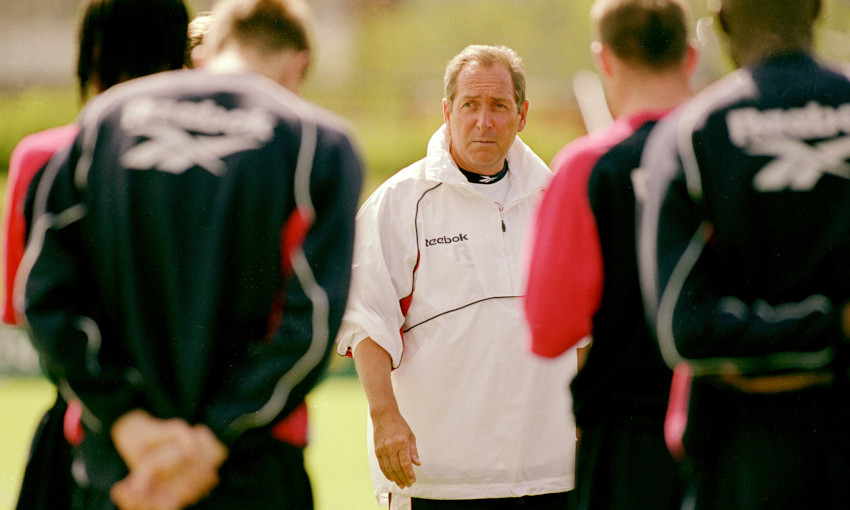Treble memories: How Houllier's trophy-winning squad was built
Gerard Houllier's Liverpool project was almost two years in the making at the outset of what would prove to be an historic 2000-01 season.
The Frenchman had taken sole charge of the Reds in November 1998 and steadily set about moulding a squad that combined local talent and passion with European pedigree.
“He always said he wanted a Liverpool heart at the core of Liverpool Football Club,” explained Houllier’s assistant manager, Phil Thompson.
“That’s what he’d known of before. That’s what he envisaged his team to go ahead. He wanted a younger team; he wanted to change it and have a young, vibrant team who could compete and sort of take on the bigger boys.”
Though transfer funds were limited at the time, Houllier, Thompson and the club’s chief executive, Peter Robinson, carefully pieced together the boss’ ambition of ‘two top players for each position’.
A seventh-placed finish in 1998-99 was followed by a leap to fourth the following season, but that progress up the table was tinged by the disappointment of missing out on Champions League qualification due to a late dip in form.
Nevertheless, they returned ahead of 2000-01 with more new additions to the team and with an increased determination to show supporters the club was moving in the right direction.
“Gerard always had this vision throughout our meetings – long meetings with Peter – [of] two top players for each position,” continued Thompson.
“We used to draw it up on graphs and everything, that’s how detailed it was. You weren’t always going to get two great players in each position but we were going to have the cover.
“This is how he set out his vision and it was just [that] it would be slow but it would be that we can compete at the top for the league title, which was the Holy Grail even then, to all the big trophies.
“To make sure that we were challenging, that the fans believed, that they could see progress – I think that was the main thing, which is the progress of the side, it was no good sort of staying on a level. They had to see us going and moving upwards.
“And I used to say to him, ‘As long as we give it time but they see us moving in the right direction, the fans will stay on board.’ Which is what they did.”
Patience was rewarded – and plenty more – for all parties when the Reds went on to deliver the League Cup, FA Cup and UEFA Cup, plus a ticket for the European Cup, over the course of nine thrilling months.
Here, in the latest entry in our series celebrating the 20th anniversary of the 2000-01 treble triumph, we take a closer look at the make-up of a squad that rose to every challenge across 63 games.
The strikers
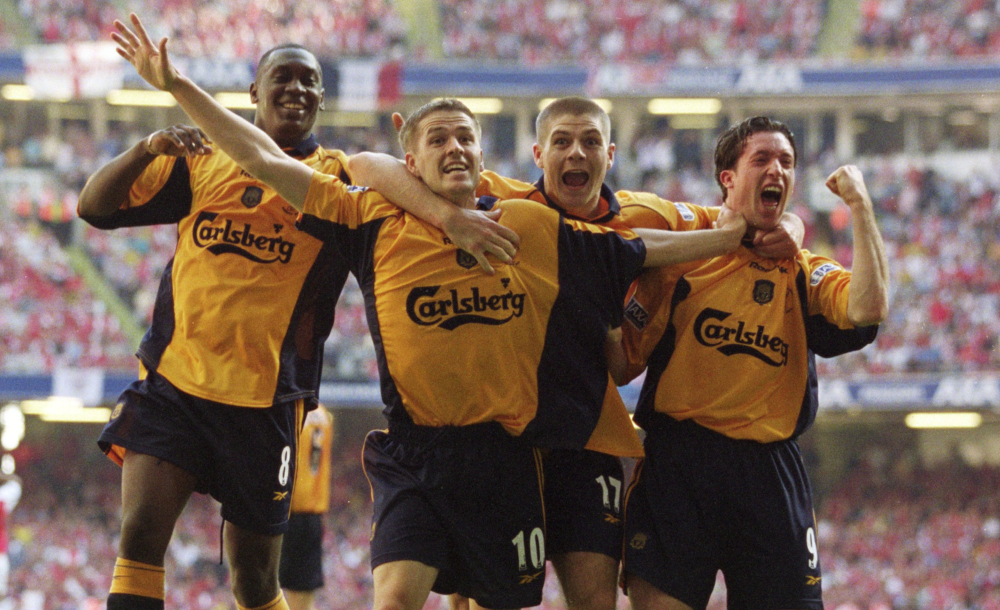
Houllier had the luxury of three top-class goalscorers at his disposal after Emile Heskey had joined Robbie Fowler and Michael Owen during the previous campaign.
The manager chopped and changed his attacking set-up as required to cope with the demands of league football and three cup competitions, pairing up his forwards depending on opposition, form and, of course, fitness.
He rarely got the formula wrong.
“I always understood what the others wanted and I tried to play around them,” said Heskey. “So it blended quite well whether it would be me with Michael, or me with Robbie, or Robbie and Michael. They all understood. And everything just clicked that season.”
Owen top-scored with 24 goals in total, including the FA Cup final double that snatched victory from Arsenal in Cardiff, and the famous brace in the Stadio Olimpico that swung the UEFA Cup tie with AS Roma in the Reds’ favour.
Heskey delivered the most prolific single season of his spell at Anfield, translating growing confidence into 22 strikes, five of which aided the run to FA Cup glory.
“Emile was literally unplayable,” said Owen. “I remember watching him and playing alongside him in certain times, but I remember sitting in the stand a couple of times, I must have been injured at the time, and watching Emile. And he was literally unplayable for a season.”
Having had to wait until the first day of November to open his season account, Fowler then netted 17 times in total and became a clutch man in the decisive weeks of the campaign.
‘God’ was on the scoresheet in the League Cup final, FA Cup quarter-final and semi-final, UEFA Cup final, in the league against Manchester United, and twice in the crucial final-day win at Charlton Athletic.
The class of Jari Litmanen was added to the group in January 2001, the Finn subsequently chipping in with two goals, while Erik Meijer had featured on three occasions before departing in the December.
- Robbie Fowler – 48 appearances, 17 goals
- Emile Heskey – 56 appearances, 22 goals
- Jari Litmanen – 11 appearances, 2 goals
- Erik Meijer – 3 appearances
- Michael Owen – 46 appearances, 24 goals
- Watch now: New documentary One Week in May: The Story of a Unique Treble
- Get LFCTV GO free for one month. Visit video.liverpoolfc.com and use code 2021GOFREE at checkout
The midfielders
A key aspect of Liverpool’s success in 2000-01 was the ability of Houllier’s midfielders to repeatedly weigh in with goals.
Indeed, five of them netted seven times or more over the course of the campaign, with Steven Gerrard and Danny Murphy leading the way with double figures as their burgeoning abilities blossomed under the manager’s tutelage.
It was certainly a landmark period in Gerrard’s formative career as the prodigious Scouser harnessed his raw talents into consistently powerful performances – form that landed him the PFA Young Player of the Year prize.
The pick of his 10 goals surely came in the 2-0 defeat of Manchester United at Anfield as he hurled a 30-yard effort into the top corner to open the scoring.
“I was at an age where I didn’t fear anyone, and I really looked forward to the challenge,” said Gerrard. “So I went into those games and those challenges and tests extremely motivated – sometimes too motivated, if you like.
“But I was very much someone who went in and was like, ‘This is my time, this is my moment to prove to everyone that I’m capable of playing against these players.’ I had no fear, at all. And I think when you’re like that and you have that attitude, you can go up against anyone you want.”
The Reds’ midfield was typically anchored by the nous and wisdom of Dietmar Hamann – then in his second year at Anfield – and Gary McAllister, whose personal campaign took on an increasingly fairy-tale quality.
Brought in on a free transfer at the age of 35, the Scot was talismanic during a run-in that was kick-started when he won the Merseyside derby at Goodison Park with a last-minute set-piece from 44 yards out.
“One of the job briefs was to come in and try to pass on any information of how to navigate from Monday to Friday, being an experienced player and I’d captained my country and stuff,” said McAllister.
“First and foremost, that was something I tried to impress upon the youngsters because when you’re starting your career you’ve got to realise that each time you go on to the training field the intensity and the concentration has got to be there. You can’t just drift during the week and then expect just to turn the tap on at the weekend.
“But, for me, what I would say is as much as I was trying to pass on experience, I definitely got a buzz off these young players. I was basically inspired by these guys as well.
“All of a sudden I was in amongst four or five young England internationals who you could see their careers were just going to go one way. So I definitely got a kick and a boost from them, so I used it to my benefit as well.”
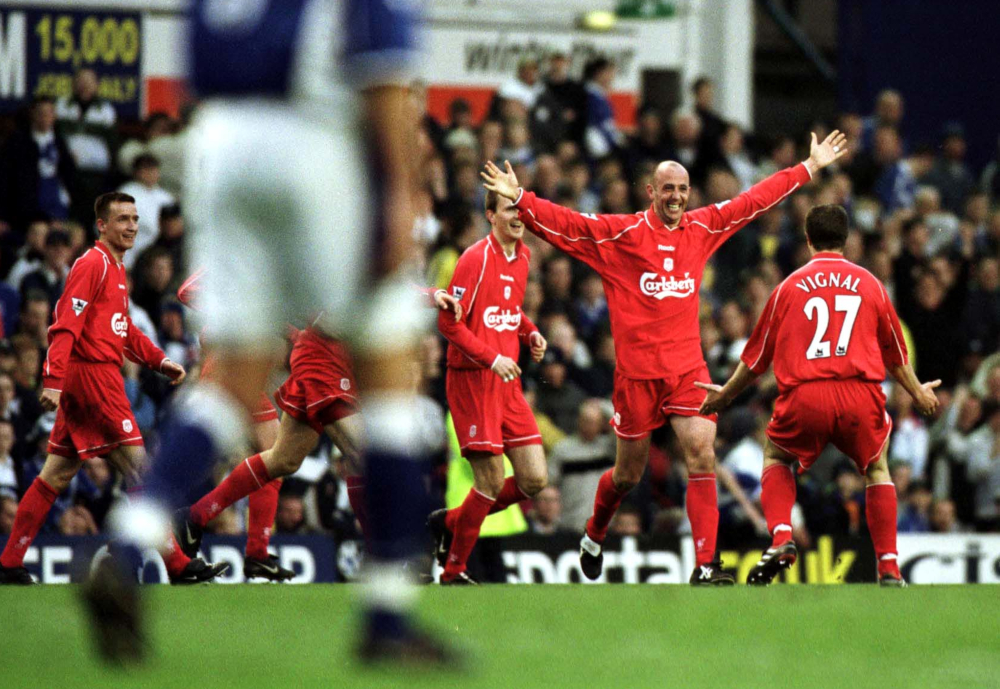
The versatile Vladimir Smicer was a consistent figure in attacking roles and provided seven goals as he fulfilled the faith Houllier retained in him after a testing debut season.
“It was tough for me [in] my first year with Liverpool, I got an ankle injury, but that second year I felt more energy and the new signings were good lads and good friends,” said the Czech.
“I think that was the base for all the success in the season. I think the camaraderie in the team showed it was a good move from the manager that he signed these players and we really started to feel like a team.”
Nick Barmby hit the ground running with eight strikes by the end of January.
The Englishman had taken the rare route to Liverpool from their neighbours across Stanley Park but blocked out the external noise to make a big impact at Anfield – including an October goal against, of course, Everton.
“Another one with a great professional attitude, was a winner,” said Thompson. “Only quite a small, frail guy but put his foot in, put his head in where it would hurt. Anything in the box.
“And he scored some vital goals, not least against the Blues. He was an inspirational signing, it was another little piece, that we were looking for, of that jigsaw. We needed more goals, we need people who are going to get from A to B.
“It was early days for Stevie, don’t forget, of what was to come. But Nicky could bring that. We knew it would cause a stir, but because of the way it was, who it was and why it was, we thought it was a risk worth taking.”
A serious injury robbed the Reds of Patrik Berger’s services for five months of the season, but he returned to play a significant part in the run-in, not least with an assist for Owen’s winning goal in the FA Cup final.
Igor Biscan was recruited from Dinamo Zagreb to bolster Liverpool’s options midway through the season and racked up 15 starts in the remainder of the campaign.
Summer signing Bernard Diomede was restricted to four games following his move from Auxerre, however, and there was one outing in the League Cup for Academy graduate Richie Partridge.
Club captain Jamie Redknapp was, unfortunately, unable to participate on the pitch but joined his teammates in a touching moment to lift the FA Cup alongside Fowler.
- Nick Barmby – 46 appearances, 8 goals
- Patrik Berger – 21 appearances, 2 goals
- Igor Biscan – 21 appearances, 1 goal
- Bernard Diomede – 4 appearances
- Steven Gerrard – 50 appearances, 10 goals
- Dietmar Hamann – 53 appearances, 3 goals
- Gary McAllister – 49 appearances, 7 goals
- Danny Murphy – 47 appearances, 10 goals
- Richie Partridge – 1 appearance
- Vladimir Smicer – 49 appearances, 7 goals
The defenders
The partnership of Sami Hyypia and Stephane Henchoz, established after both joined the club in 1999, formed the rock at the heart of Liverpool’s mean defence under Houllier.
Their effective combination underpinned a tally of 28 clean sheets for the Reds, while Hyypia’s threat in the opposition area was reflected by his four goals.
“I think you need complementary centre-backs,” said Henchoz. “What I mean is, when you’ve got two centre-backs you need somebody who will be sometimes better in heading the ball, will be quicker, will be more comfortable on the ball.
“And you need two centre-backs who complement each other. I think that’s what the case was with Sami, for example – we were very complementary. And that’s why it was working very well together.”
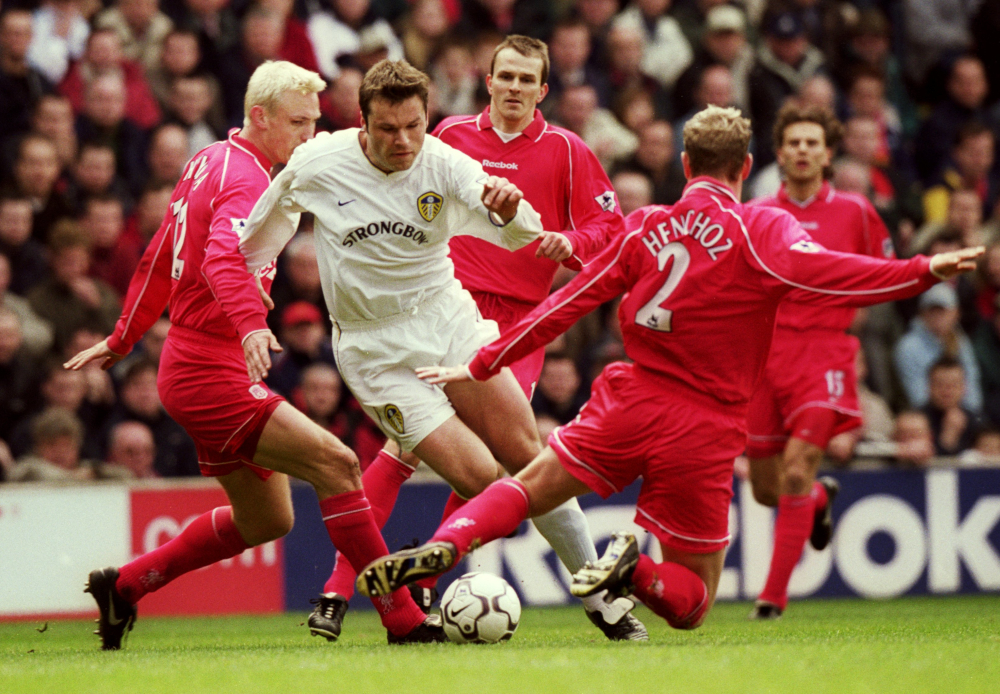
The arrival of right-back Markus Babbel on a free transfer meant Jamie Carragher was deployed on the left-hand side of the defence for the majority of 2000-01, creating a formidable backline.
“The team was more of a, I wouldn’t say defensive team as such because we had lots of attacking talent in there and lots of people who could score goals,” said Carragher. “But there was no doubt a Gerard Houllier team was based on the solidity and that defensive structure and organisation.”
Germany international Babbel, brought in after he left Bayern Munich, proved one of the bargain signings of LFC, and indeed football, history.
He featured in all 38 league matches and each of the 13 European ties, missing only three games in all competitions, and also contributed six goals – including the UEFA Cup final opener in his home country.
“He was one of those players we had on the radar,” said Thompson. “Could we make it happen? Could we do it?
“You saw this fella was so cultured, he was wonderful. Nothing seemed to faze him, which I think is a great attribute for a defender, for a full-back. And he was great in the air, he was good on his distribution.
“He was not the quickest, Markus, but I looked at him like Phil Neal. And Phil was never the quickest, but everything else he had in his locker. This guy was a 6ft2, 6ft3 giant and what a wonderful guy.
“What he also brought was he was able to play at centre-half if anything happened to Sami or Stephane at that particular time, he could slot in. And we had numerous players there who could fill in in the full-back positions, the likes of Carra in those days. Carra could play right-back or left-back. So we had a lot of places all covered.”
Christian Ziege offered further versatility along the left flank following his August switch from Middlesbrough, playing more than 30 games.
And the defence was supported over the course of the season by Djimi Traore, Gregory Vignal and Stephen Wright, while Rigobert Song and Steve Staunton were involved intermittently until departing before the New Year.
Vegard Heggem was sadly restricted to four appearances in the early months of the season as an injury in October prevented him from playing again in 2000-01.
- Markus Babbel – 60 appearances, 6 goals
- Jamie Carragher – 58 appearances
- Vegard Heggem – 4 appearances
- Stephane Henchoz – 53 appearances
- Sami Hyypia – 58 appearances, 4 goals
- Rigobert Song – 4 appearances
- Steve Staunton – 2 appearances
- Djimi Traore – 12 appearances
- Gregory Vignal – 7 appearances
- Stephen Wright – 4 appearances
- Christian Ziege – 32 appearances, 2 goals
The goalkeepers
Dutchman Sander Westerveld made the most appearances of any Liverpool player in 2000-01.
The goalkeeper sat out just two League Cup ties, for which he was deputised by Pegguy Arphexad, and was otherwise ever-present as the last line of defence for the Reds.
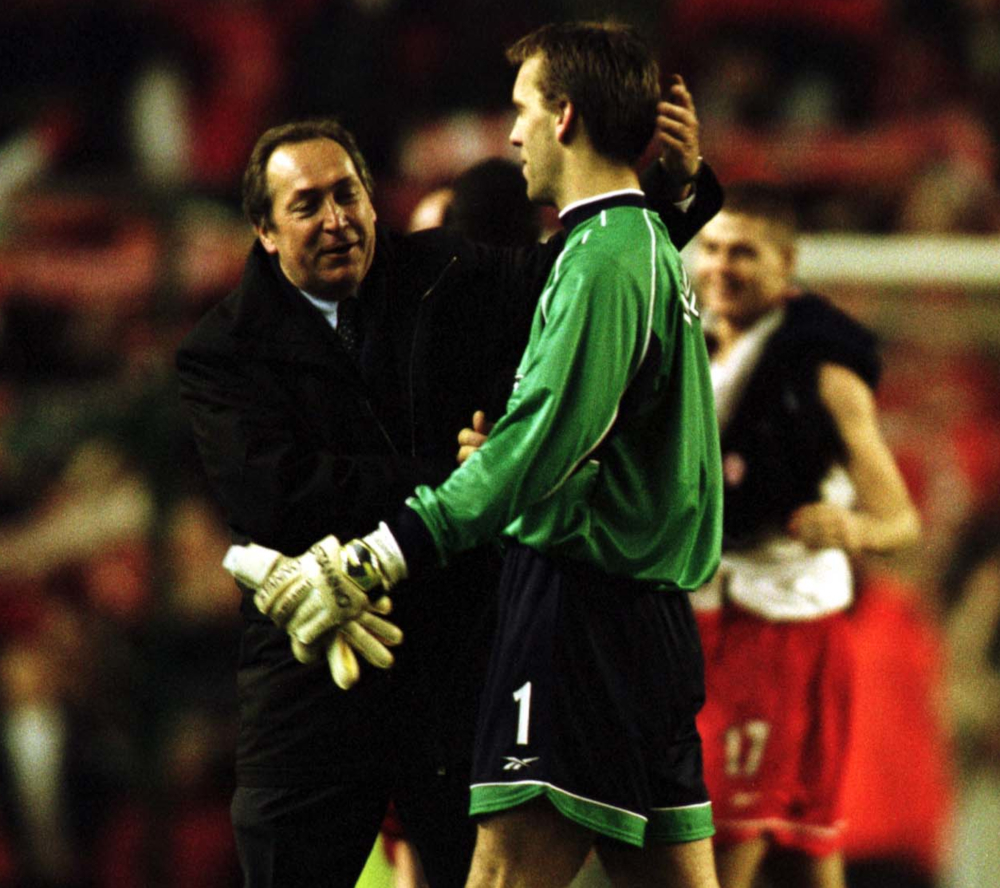
“The balance just clicked from day one and the great thing was we didn’t just have a team, we had a squad,” summarised Westerveld.
“The famous Houllier rotation system worked, especially in the cup games, we changed the team but it worked and everyone was hungry for success.”
- Pegguy Arphexad – 2 appearances
- Sander Westerveld – 61 appearances


